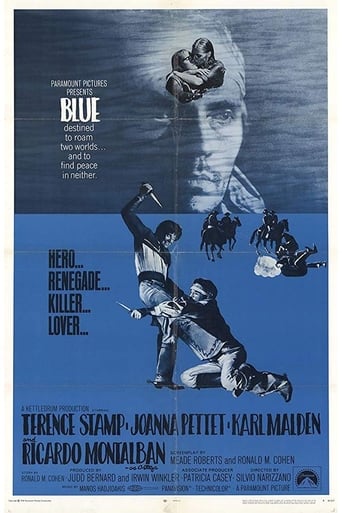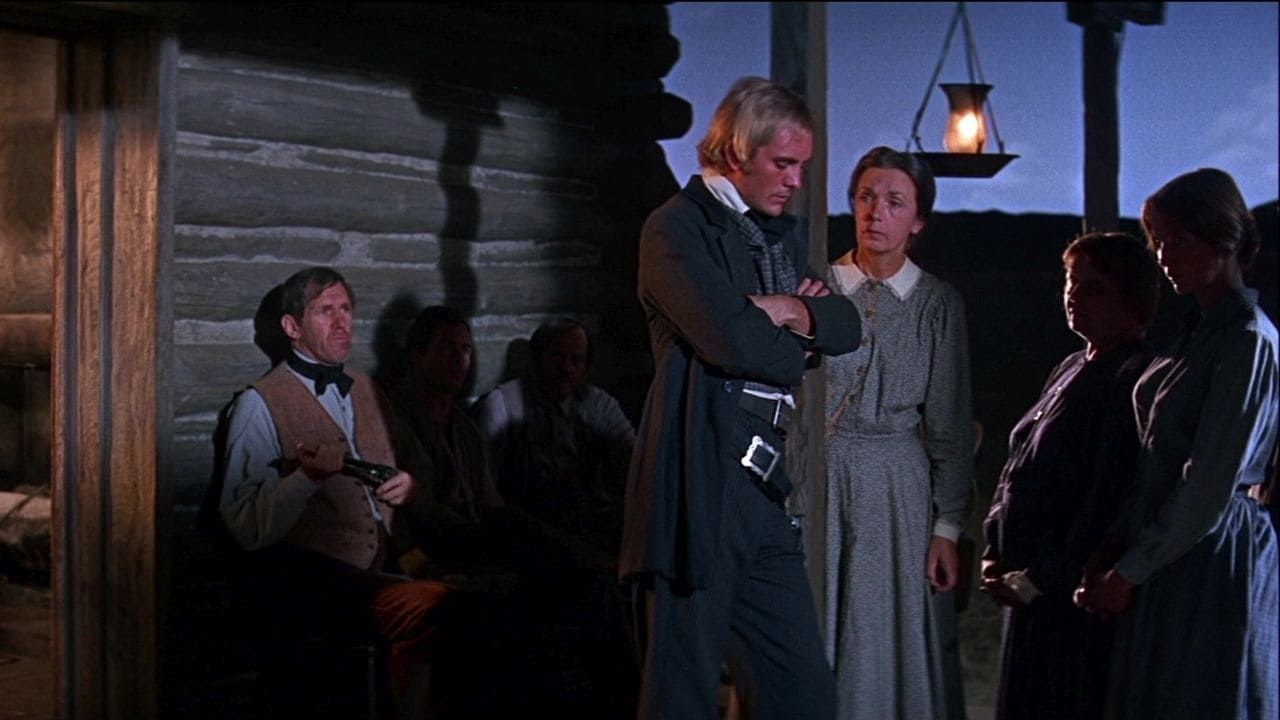merklekranz
Although less effective than the Sergio Leone "spaghetti westerns", "Blue" deserves to be ranked up there with the likes of "The Big Gundown", and "Hang Em High". Let's start with the photography. It is better than any of the above mentioned films, including "Once Upon a Time in the West". The only flaws that keep "Blue" from greatness, are the melodramatic elements, and a less than convincing romance. Terence Stamp's torn allegiance between Mexican and American sides is perhaps overplayed, and tends to drag down the middle of the movie somewhat. However the opening and finale more than cover this annoyance. If you are a fan of the "spaghetti westerns", then "Blue" is a must see. - MERK
MARIO GAUCI
This kicks off a four-movie tribute to the recently-deceased Silvio Narizzano who, in spite of his Italian name and Canadian origins, worked almost exclusively in English-language films; he made his name with the Oscar-nominated "Swinging Sixties" hit GEORGY GIRL (1966) which briefly took him to Hollywood where – like his contemporary Sidney J. Furie with THE APPALOOSA (1966) – he found himself turning a very ordinary cowboy tale into a Western with pretensions. In fact, I had missed out on this one a couple of times on Italian TV over the years, owing perhaps to its bad rep (Leonard Maltin rates this a measly *1/2) and, thus, made for a surprising choice to be issued on DVD (albeit emerging a no-frills affair) from Paramount...but, for this same reason, was extremely well-served by the transfer that utilized a gorgeous print whose colors leapt right off the screen on my 40" HD-TV!In any case, this is a Western that, while not quite following the "Spaghetti" model (apart from the reasonably graphic violence), was still deemed an arty aberration (not least because it had British leads!) – stylistically, the film seemed to evoke the self-indulgent ONE-EYED JACKS (1961; down to recruiting Karl Malden for a major role!) whereas, thematically, it owed a good deal to HOMBRE (1967) with its racial issues and martyr hero. Its lack of critical and commercial success, for one thing, sent off star Terence Stamp (as much a brooding presence here – he is silent for the first half-hour or so, with the title itself a reference to the color of his eyes and, in fact, he goes by the name Azul i.e. Spanish for 'blue' – as Marlon Brando and Paul Newman in the two-mentioned films respectively) into a 10-year period of European wanderings mainly devoted to highbrow/obscure fare! For the record, it was originally intended for Robert Redford who, bailing out at the proverbial 11th hour, subsequently found himself slapped with a lawsuit by the studio for breach-of-contract! The cast includes a couple of other popular names from this era: Joanna Pettet (who had been one of THE GROUP {1966}, here affecting a convincing drawl – though her acting and Stamp's is too modern for the genre, this only adds to the inherently offbeat nature of the film) and Stathis Giallelis (if only in a minor role – he is dispatched early on – having been the lead in Elia Kazan's America, America {1963}). Rounding out the protagonists are Malden, ever-reliable while not particularly taxed by his role of Pettet's dad (a doctor and thus a leading member of the settlers) and Ricardo Montalban, excellent as Stamp's own bandit-leader father (albeit only a surrogate) who had singled him out as his successor but now is inevitably drawn towards a face-off with him.Typically, when he is prone to be civilized, the hero has to withstand backlash from both the whites for his 'animalistic' behavior (especially from Pettet's boyfriend, though the two men eventually make up and the latter is virtually made Stamp's lieutenant!) and his adoptive 'family' for turning on them (he killed a 'brother' who had tried to rape the heroine). With this in mind, the finale is properly tinged with tragic poignancy as son shoots father dead and is himself gunned down by an uncle! When Montalban threatens to decimate the entire community over what he takes to be Stamp's treason, the latter feels obligated to teach the settlers how to defend themselves: though booby traps are effectively laid along the stretch of beach where the battle is waged, the bandits' come-uppance is dealt a bit too quickly and overwhelmingly (with few losses among their own numbers!); incidentally, Pettet takes a nasty fall (clearly unintended) during her rush to comfort the dying Stamp which the director opted to retain for the finished version! In the end, the chief assets here emerge to be pictorial and aural – courtesy of Stanley Cortez' sprawling cinematography and Manos Hadjidakis' flavorful score respectively – and these go a long way towards smoothing over the obvious narrative deficiencies (in the form of clichéd characterization and situations). A curious footnote: the contemporaneous FADE IN, a made-for-TV effort about the movie-making business that starred Burt Reynolds and which would eventually be credited to the fictitious Alan Smithee, reportedly features behind-the-scenes footage from the set of BLUE!
highwaytourist
In spite of a somewhat interesting premise, this turned out to be completely routine, similar to many westerns of the 1960's. British actor Terence Stamp is completely miscast in the title role, playing a Mexican-raised white bandito (gringro) who is cast into American society after stopping one of his compatriots from raping a woman during a raid. The rest of the cast includes some excellent actors (Karl Malden, Ricardo Montoblan, & Sally Kirkland), but they're stuck in cliché roles and can only go through the motions. The beginning and end of this film feature the usual shootouts and horseback chases, while the middle section is mostly the supporting cast talking. And boy do they talk, and it's the kind of talk you've heard in every western ever made. However, Stanley Cortez's color photography is lovely and it takes full advantage of the scenery. In the romantic lead, Joanna Pettet is also very beautiful, but her romance with Stamp's character is unconvincing. It's hardly worth two hours of melodrama and clichés. I'd call this strictly for hard-core fans of westerns.
The Fuzz
Terence Stamp is an actor of some range, but that range doesn't extend to playing naturalized Mexicans. His extreme unsuitability for his role is apparent as soon as he speaks: his first words - "I'll do that" - are delivered in what appears to be thick cockney; a little later his delivery has a Devon burr. Only when Blue gave an account of his upbringing did I realised he was meant to be American. The mystery is why, having kept their leading man silent for the first forty-five minutes, the film-makers should have allowed him to speak at all.



 AD
AD


